Airport rail link
An airport rail link is a service providing passenger rail transport from an airport to a nearby city by mainline or commuter trains, rapid transit, people mover, or light rail. Direct links operate straight to the airport terminal, while other systems require an intermediate use of people mover or shuttle bus.
Although airport rail links have been popular solutions in Europe and Japan for decades, only recently have links been constructed in North America, Oceania, and the rest of Asia. Advantages for the rider include faster travel time and easy interconnection with other public transport, while authorities have benefited from less highway and parking congestion, less pollution, and additional business opportunities. Additionally, the links benefit airports by drawing in more passengers via easy access.
Mass transit
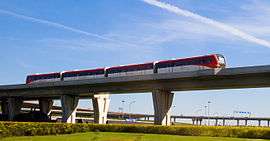
For airports built within or close to the city limits, extending mass transit urban rail systems like rapid transit or light rail to airport terminals allows full integration with other public transport in the city, and seamless transport to all parts of town. Service frequency will be high, although travel time is a drawback as the services make many intermediate stops before reaching the city center and thus there may not be enough space for the baggage commonly carried by airport-bound passengers. Furthermore, luggage stowing facilities are not commonly found on mass transit vehicles as their primary objective is to provide high-capacity transport, as in the Airport, Inner West & South Line in Sydney, Australia. A common solution involves building a separate people mover from a mass transit station to the airport terminal (see below), often using automated systems, allowing faster travel time and fare discrimination, for instance Orlyval. Because they are solely dedicated to passengers using the airport, luggage stowing facilities are more likely to appear on these systems.
The first rapid transit station to connect an airport with a mass transit system was the Berlin U-Bahn's Paradestraße station which opened in 1927 as Flughafen (Airport) and was built to provide direct access to Berlin Tempelhof Airport. The connection between Tempelhof Airport and the Berlin U-Bahn at Paradestraße was however revoked in 1937 and the preceding station Platz der Luftbrücke was instead granted that connection and remained so until Tempelhof Airport's closure in 2008. Other early examples of mass transit stations located at airports include the MBTA Blue Line's Airport station which is situated at Boston's Logan International Airport and opened for service in 1952 and rebuilt in 2004, and Cleveland RTA Rapid Transit Red Line's Cleveland Hopkins International Airport station which opened in 1968 and rebuilt in 1994, although Cleveland's rapid transit is considered the first direct airport-to-downtown rapid transit system in the Western Hemisphere. Boston's Blue Line requires a short bus transfer from the airport rail station to the airport terminal.
Mainline rail
Dedicated railway lines to airports have become popular since the 1980s. In many cases, there are stations at the airport terminal(s) for express, intercity and commuter trains, allowing direct travel to the check-in halls. In most cases, this solution requires the building of new track, whether it is a newly built main line or a branch (spur) line from an existing main line.
A cheaper option is to open a new station on an existing line, again connected to the airport by people mover or shuttle bus (see below). While this option is commonly chosen to reduce construction costs, it is only feasible when the station is located within proximity to the airport itself. Some early examples of mainline rail stations built to serve an airport are Berlin Schönefeld Flughafen station (which opened in 1951 and serves Berlin Schönefeld Airport), Brussels National Airport railway station (which opened in 1958 and serves Brussels Airport) and Frankfurt Airport regional station (which opened in 1972 and is one of the two railway stations that serve Frankfurt Airport).
Integration with intercity services has produced alliances where airlines sell air tickets that include the connecting rail service. Central Europe has seen integration of high-speed rail into airports, with domestic and international TGV and ICE services from Charles de Gaulle Airport in Paris and Frankfurt Airport. Because of this, many airport railway stations have received IATA codes.
Yet another option for airports is to use a high-speed "airport express" train to the city centre, especially if the airport is outside the urban area and some way from the mass transit system, but a direct downtown service is required, such as Flytoget serving Oslo Airport, Gardermoen. There are various ways this can be done: it may operate on a combination of existing and newly built mainline rail or mass transit track using a dedicated fleet of rolling stock designed for airport service. These solutions often have the drawback of lower frequencies (e.g. twice per hour), and often charge a premium fare higher than other services, but are more likely to have luxury features such as luggage racks, power outlets, Wifi, and washrooms.
Most dedicated railways use mainline trains and trackage, while mass transit "airport express" lines are usually found in Asia, as in the case of the Airport Express Line in Hong Kong. Other airports, such as Heathrow Airport, are served by both express trains and mass transit.
Shuttle
In many cases, there is no train station directly at the airport, usually because the infrastructure on which the service operates makes it impractical to build such a station. When this happens, a shuttle system is required for the last part of the journey; using either a people mover (often automated, such as AirTrain JFK in New York City) or a bus. The former allows low operating costs and higher perceived quality; the latter does not require specialized infrastructure to be built, and is often the preferred choice at smaller or low-cost airports. Shuttles do not provide a direct connection, and often involve a wait for a transfer to the next stage of the journey. Thus their market shares are often lower.
In some airports, such as San Francisco International Airport, the rail link may not serve some or all of the terminals or concourses directly; passengers using terminals that lack such connections must use a people mover or airport circulator to access their terminal. These circulators typically also serve parking lots, and sometimes airport hotels and off-site car rental locations.
Connection types
One-seat ride via main-line train
Commuter rail-type service directly from a city centre to the airport, without needing to change trains and sometimes without intermediate stops.
Africa
- Casablanca Airport, Morocco, via ONCF.
- Johannesburg OR Tambo International Airport via Gautrain
Asia
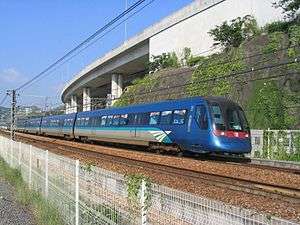
- Bangkok, Pathumthani (Pass Don Muang International Airport (Older name Bangkok International Airport) and Samutprakarn (Pass Suvarnabhumi International Airport)
- Changchun Longjia International Airport via Changchun–Jilin Intercity Railway
- Chengdu Shuangliu International Airport via Chengdu-Mianyang-Leshan Intercity Railway
- Chennai International Airport via Chennai Metro
- Guiyang Longdongbao International Airport via Guiyang–Guangzhou High-Speed Railway
- Haikou Meilan International Airport via Hainan Eastern Ring Railway
- Hong Kong International Airport via Airport Express
- İzmir Adnan Menderes Airport via Suburban Train of İzmir
- Jakarta Soekarno-Hatta International Airport via Soekarno-Hatta ARS
- Kuala Lumpur International Airport via KLIA Ekspres
- Lanzhou Lanzhou Zhongchuan Airport via Lanzhou–Zhongchuan Airport Intercity Railway
- Medan Kualanamu International Airport via Kualanamu ARS
- Nagoya Chubu Centrair International Airport via Nagoya Railroad's Meitetsu Airport Line
- Osaka Kansai International Airport via JR West's Haruka and Nankai Railway's Rapi:t
- Padang Minangkabau International Airport via Minangkabau Airport Rail Link
- Phnom Penh International Airport from Phnom Penh railway station[1]
- Pyongyang Pyongyang International Airport via Korean State RailwayPyongui Line Sunan Station
- Sanya Phoenix International Airport via Hainan Western Ring Railway
- Sapporo New Chitose Airport via JR Hokkaido's Chitose Line
- Seoul Incheon and Gimpo airports via A'REX
- Sendai Airport via Sendai Airport Line
- Shanghai
- Shenzhen
- Tel Aviv Ben Gurion International Airport via Israel Railways
- Tokyo Narita International Airport via JR East's Narita Express and Keisei Electric Railway's Skyliner
- Tokyo International Airport (Haneda Airport) via Tokyo Monorail and Keikyu's Airport Line
- Taipei Taiwan Taoyuan International Airport (TPE) express train to Taipei Main Station. Part of Taoyuan Mass Rapid Transit System.
- Turpan Jiaohe Airport via Turpan North Station of the Lanzhou–Ürümqi High-Speed Railway
- Vladivostok International Airport via Aeroexpress, also makes several stops along the way in a commuter service
- Wuhan Tianhe International Airport via Tianhe Airport Station of the Wuhan–Xiaogan Intercity Railway
- Zhengzhou Xinzheng International Airport via Xinzheng Airport Station of the Zhengzhou–Xinzheng Airport Intercity Railway
Europe
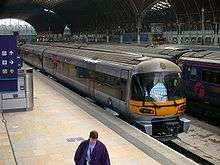
- Amsterdam Schiphol Airport via the Thalys and Nederlandse Spoorwegen (Dutch Railways)
- Athens Eleftherios Venizelos Airport via the Proastiakos suburban railway service
- Barcelona International Airport via RENFE commuter train and by Metro line 9 South
- Belfast George Best Belfast City Airport via Belfast-Bangor Line run by Northern Ireland Railways.
- Berlin Brandenburg Airport via regional, InterCity, InterCityExpress and EuroCity rail (currently delayed due to airport construction issues)
- Birmingham Airport via Arriva Trains Wales, CrossCountry, Virgin Trains West Coast and West Midlands Trains.
- Brussels Airport via National Railway Company of Belgium
- Budapest Ferihegy International Airport by MÁV (to and from the now defunct Terminal 1 only)
- Cologne Bonn Airport via ICE high-speed, regional and local trains.
- Copenhagen Airport via Kystbanen and InterCity services; direct trains to many cities in Denmark and Sweden.
- Düsseldorf Airport via ICE high-speed, InterCity, regional and local trains.
- Frankfurt International Airport via ICE high-speed, InterCity, S-Bahn, regional and local trains.
- Friedrichshafen Airport near Lake Constance by regional train.
- Geneva-Cointrin Airport via Swiss Federal Railways
- Glasgow, Prestwick International Airport via the Ayrshire Coast Line.
- Helsinki Airport via Helsinki commuter rail via the Ring Rail Line.
- Kazan International Airport via Aeroexpress to Kazan–Passazhirskaya.
- Kerry Airport via Mallow-Tralee line from Farranfore run by Irish Rail.
- Krakow Airport to/from city centre via local trains
- Leipzig/Halle Airport via local and InterCity trains.
- London
- Heathrow Airport via Heathrow Express and TfL Rail.
- Gatwick Airport via Gatwick Express and other Brighton Main Line services.
- Stansted Airport via Stansted Express, Abellio Greater Anglia and CrossCountry.
- Southend Airport via Abellio Greater Anglia service.
- Lyon airport via TGV.
- Lübeck, Lübeck Airport non-stop via regional trains.
- Manchester Airport (Northern, TransPennine Express, Arriva Trains Wales).
- Málaga Airport via Cercanías Málaga service.
- Milan Malpensa International Airport via Malpensa Express.[2]
- Moscow. Trains operated by Aeroexpress company to the city's three main airports:
- Oslo Airport, Gardermoen via the Airport Express Train and InterCity trains.
- Paris Charles de Gaulle Airport via TGV to many French cities
- Palermo Airport via local trains
- Pisa Galileo Galilei International Airport: connections to Pisa's central station and Florence
- Rome Leonardo Da Vinci International Airport via Leonardo Express,[3] the station is also served by the regional service FL1
- Sochi International Airport via Aeroexpress
- Sofia Airport via Sofia Metro
- Southampton Airport by CrossCountry and South Western Railway
- Stockholm Arlanda Airport via Arlanda Express service, InterCity, Regional and local commuter train services.
- Strasbourg Airport via TER Alsace regional trains
- Turin Caselle Airport via Ferrovia Torino-Ceres
- Vienna International Airport via City Airport Train (CAT)
- Vilnius International Airport via Lithuanian Railways
- Szczecin "Solidarity" Szczecin–Goleniów Airport via Przewozy Regionalne
- Warsaw Frederic Chopin Airport via Szybka Kolej Miejska (Warsaw).
- And new Modlin Airport being built for no-frills airlines (rail to be opened later)
- Trondheim Airport, Norway, via regional trains on the Nordland Line.
- Zürich Airport via Swiss Federal Railways
North America
- Anchorage International Airport via Alaska Railroad (Service available to cruise passengers only)
- Bob Hope Airport (Los Angeles area) via Metrolink and Amtrak
- Denver International Airport via Regional Transportation District A-Line
- Philadelphia International Airport via SEPTA Regional Rail
- Providence T.F. Green Airport via MBTA Commuter Rail
- South Bend Regional Airport via South Shore Line
- Toronto Pearson International Airport via Union Pearson Express
Oceania
- Brisbane Airport, Brisbane via Airtrain
- Sydney Airport, Sydney via Airport, Inner West & South Line
One-seat ride via local public transport
Many cities also provide a link to their airports through their rapid transit or light rail systems, which, unlike express trains, often make numerous stops on the way to the airport. At some airports, such as O'Hare in Chicago or Hartsfield-Jackson in Atlanta, the rapid transit train only visits one terminal or concourse; passengers must transfer to an airport circulator (people mover system) to reach other terminals or concourses.
Asia
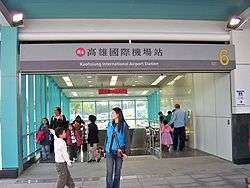
- Bangkok Suvarnabhumi International Airport via Suvarnabhumi Airport City Line
- Beijing Capital International Airport via Beijing Subway Airport Line
- Busan Gimhae International Airport via BGLRT
- Chengdu Shuangliu International Airport via Chengdu Metro Line 10
- Changsha Huanghua International Airport via Changsha Maglev
- Chennai International Airport via Chennai Metro Blue Line
- Chongqing Jiangbei International Airport via Line 3 and Line 10
- Dalian Zhoushuizi International Airport via Dalian Metro Line 2
- Dubai International Airport via Dubai Metro Red Line
- Fukuoka Airport domestic terminals via Fukuoka City Subway Kuko Line
- Guangzhou Baiyun International Airport via Line 3
- Gwangju International Airport via Gwangju Subway Line 1
- İzmir Adnan Menderes Airport via Suburban Train of İzmir
- Kaohsiung International Airport via Kaohsiung Mass Rapid Transit Red Line
- Kolkata Netaji Subhash Chandra Bose International Airport via Kolkata Suburban Railway Airport Line EMUs (known as BimanBandar Locals)
- Kobe Airport via Port Liner
- Kuala Lumpur
- Kunming Changshui International Airport via Line 6
- Mumbai Chhatrapati Shivaji International Airport via Mumbai Metro (under construction)
- Naha Airport via Okinawa Monorail
- Nanjing Lukou International Airport via Line S1
- New Delhi Indira Gandhi International Airport via Delhi Airport Metro Express (Orange Line of Delhi Metro)
- Ningbo Lishe International Airport via Line 2, Ningbo Rail Transit
- Osaka International Airport (Itami) via Osaka Monorail
- Padang Minangkabau International Airport via Minangkabau ARS
- Palembang's Sultan Mahmud Badaruddin II International Airport via Palembang LRT
- Seoul Gimpo International Airport via Seoul Subway Line 5 & Line 9
- Shanghai
- Shenyang Taoxian International Airport via Shenyang Modern Tram line 2
- Shenzhen Bao'an International Airport via Shenzhen Metro Line 11
- Singapore Changi Airport via SMRT Corporation's East West MRT Line Changi Airport Branch (cross-platform interchange required to main branch of East West MRT Line at Tanah Merah MRT Station)
- Taipei
- Tianjin Binhai International Airport via Tianjin Metro Line 2
- Tehran
- Mehrabad International Airport via Tehran Metro Line 4 Mehrabad Branch (transfer required to main branch of Line 4 at Bimeh)
- Tokyo Narita International Airport via JR East's Airport Narita and Keisei Electric Railway Sky Access and Keisei Mainline
- Tokyo Haneda Airport via Tokyo Monorail's Local and Rapid services or Keihin Electric Express Railway
- Yogyakarta Adisutjipto International Airport served by Prameks (Prambanan Ekspress) commuter serving Yogyakarta-Solo Balapan-Palur corridor.
- Zhengzhou Xinzheng International Airport via Zhengzhou Metro Chengjiao Line.
Europe
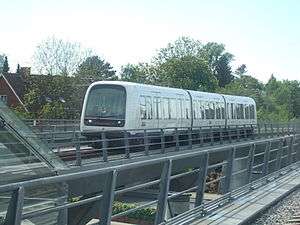
- Athens Eleftherios Venizelos Airport via the Athens Metro
- Bergen Airport via Bergen Light Rail
- Berlin Brandenburg Airport via Berlin S-Bahn (under construction, Berlin-Schonefeld International Airport connected until then)
- Bremen Airport by Bremer Straßenbahn
- Copenhagen Airport via Copenhagen Metro
- Dresden Airport via Dresden S-Bahn
- Edinburgh Airport via Edinburgh Trams. This links into Edinburgh Gateway station on the existing Edinburgh to Aberdeen railway line, providing mainline rail connections to the airport.
- Frankfurt International Airport via Rhein-Main S-Bahn and Regional-Express.
- Hamburg Airport via Hamburg S-Bahn, mass rapid transit, S1
- Hannover Airport via S-Bahn
- Helsinki, Helsinki-Vantaa Airport via Ring Rail Line
- Istanbul Ataturk International Airport via Istanbul Metro M1
- Kerry Airport via Iarnród Éireann services to Farranfore from Tralee and Mallow
- Kiev International Airport via Kiev Urban Electric Train and commuter and regional trains stopping at Kiev-Volynskyi station (0.5 km away from the airport)
- London:
- Lisbon Airport via Lisbon Metro
- Lyon Airport via Rhônexpress
- Madrid Barajas International Airport via Madrid Metro Line 8. It used to have check-in facilities in the city center terminus of the line, that has been abandoned due to high costs and low use. Also via Cercanías Madrid commuter trains by RENFE (which commenced service in 2011).
- Manchester Airport via Manchester Metrolink.[4]
- Munich International Airport via Munich S-Bahn
- Newcastle Airport via the Tyne and Wear Metro
- Nuremberg Airport via Nuremberg U-Bahn
- Oporto via Metro do Porto
- Paris Charles de Gaulle Airport via RER B
- Paris Orly Airport via Tramway T7
- Stockholm Arlanda Airport via the Stockholm Commuter Rail
- Stuttgart Airport via Stuttgart S-Bahn
- Vienna International Airport via Vienna S-Bahn
- Zurich Airport via Zürich trams and Stadtbahn Glattal
North America
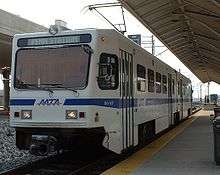
- Hartsfield-Jackson Atlanta International Airport (domestic terminal) via MARTA
- Baltimore-Washington International Airport via Baltimore Light Rail
- Cleveland Hopkins International Airport via Cleveland RTA Red Line
- Chicago
- Dallas-Fort Worth International Airport via DART Orange Line
- Mexico City International Airport via the Mexico City Metro's Line 5
- Minneapolis-Saint Paul International Airport via the METRO Blue Line
- Oakland International Airport via Bay Area Rapid Transit
- Phoenix Sky Harbor International Airport via free PHX Sky Train and Valley Metro Rail
- Portland International Airport via MAX Light Rail (Red Line)
- Salt Lake City International Airport via TRAX (Green Line)
- San Francisco International Airport via Bay Area Rapid Transit
- Seattle-Tacoma International Airport via Central Link
- St. Louis' Lambert-St. Louis International Airport via the St. Louis MetroLink
- Vancouver International Airport via SkyTrain Canada Line
- Ronald Reagan Washington National Airport via the Washington Metro
- Dulles International Airport via Washington Metro (under construction)
South America
- Rio de Janeiro Santos Dumont Airport via Rio de Janeiro Light Rail
- Porto Alegre Salgado Filho Airport via Porto Alegre Metro
Rail to airport people mover
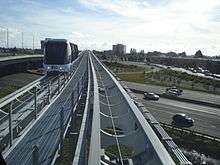
A hybrid solution adopted in some cities is a direct rail connection to an airport train station instead of to the airport itself. At the airport train station, the passenger switches to a people mover or other train that goes to the airport terminals. The same system can also serve passengers moving between different terminals and traveling between the terminals and car rental lots or parking areas. Several very large airports have rail stations near some terminals, but people movers are used by many to get to some other terminals. Examples: Paris-de Gaulle and Oakland.
Asia
Europe
- Paris Orly Airport via Orlyval, a people mover that connects to the RER network at Antony
- Birmingham Airport via a pair of light-rail vehicles, connects the airport terminal to Birmingham International railway station, where the West Coast Main Line runs to Birmingham New Street, Coventry and London
- Düsseldorf Airport via SkyTrain a short suspension railway that connects the terminals with the airport railway station (see above)
North America
- John F. Kennedy International Airport in New York City via AirTrain JFK to Jamaica station (Long Island Rail Road trains and New York City Subway E, J, and Z trains) or Howard Beach – JFK Airport (A train).
- Miami International Airport via an airport People Mover and Miami Central Station, which is a stop for the Miami-Dade Metrorail and Amtrak and Tri-Rail.
- Newark Liberty International Airport via AirTrain Newark and its train station, a stop for Amtrak and NJ Transit (Used by United Airlines as if it were a connecting airline.[5])
- Oakland International Airport via BART to OAK Airport, a BART Automated Guideway Transit (AGT) system between the Coliseum Station (BART and Amtrak) and Oakland International Airport (BART station) that connect to the airport terminal buildings.
- Phoenix Sky Harbor International Airport via PHX Sky Train to 44th St/Washington station of the Valley Metro Rail system.
- San Francisco International Airport via AirTrain SFO. While the BART station is immediately adjacent to the International terminal and all terminals are physically connected, many people transfer to AirTrain to get to other terminals because of the airport's large size.
Rail to bus to airport
Another common arrangement requires the passenger to take a train (or metro) to a railway station (usually) near the airport and then switch to a bus that goes to the airport terminals. Most medium and large size airports have bus connections from the inner city. This list only contains connections by bus from a railway station strongly associated, by branding or by name, with the airport.
Asia
- Cheongju International Airport via shuttle bus from Korail Cheongju Airport Station.
- Daegu International Airport via local buses from Daegu Subway Ayanggyo Station.
- Fukuoka Airport international terminal via a shuttle bus from Hakata Station.
- Hualien Airport via Hualien Transportation Bus number 1123 from Hualien Station.
- Hengchun Airport via Pingtung Bus number 8205 from Pingtung Station or Jialu Station or number 9188 from Kaohsiung Station and Xinzuoying Station.
- Hong Kong International Airport via bus no. S1 from Tung Chung MTR Station.
- Kuala Lumpur
- Kuala Lumpur International Airport & KLIA2 via express shuttle bus from KL Sentral & Terminal Bersepadu Selatan-Bandar Tasik Selatan (TBS-BTS) or transit bus at Nilai commuter station.
- Subang Airport via transit bus no. 772 from Pasar Seni & LRT feeder bus no. T773 from Ara Damansara.
- Ninoy Aquino International Airport via shuttle bus from Taft Avenue MRT Station and Baclaran LRT Station.
- Shenzhen Bao'an International Airport via bus no. M416 from Hourui Station on the Luobao Line (For current terminals)
- Shijiazhuang Zhengding International Airport via shuttle bus on dedicated roadway from Zhengding Airport Railway Station on the Beijing–Guangzhou High-Speed Railway
- Taichung International Airport via Taichung Bus number 9 and 69 from TRA Taichung TRA station or no. 115 from THSR Taichung Station and Xinwuri Station.
- Tainan Airport via Shinan Bus number Red 3 from TRA Tainan Station, THSR Tainan Station or Bao'an Station, H31 from THSR tainan Station; Tainan City Bus number 5 also provides some part-time runs via TRA Tainan Station.
Europe
- Aberdeen Airport, Scotland via Dyce railway station and 80 Dyce Airlink shuttle bus. In addition to linking the airport with Aberdeen, Dyce railway station also provides direct connections to Edinburgh, Glasgow and Inverness, as well as intermediate stations on those lines.
- Bristol Airport, England, by frequent express bus from Bristol Temple Meads railway station
- Bucharest's Henri Coandă International Airport via P.O. Aeroport Station, located about 900 m from the airport, and a shuttle bus timed to offer connections with all trains (every half hour). Combo (bus plus train) tickets are sold under the 'Henri Coanda Express' brand.
- Cardiff International Airport, Wales via Arriva Trains Wales services and a frequent shuttle bus from Cardiff International Airport Station.
- Glasgow International Airport via shuttle bus from Paisley Gilmour Street railway station
- Liverpool John Lennon Airport via regular shuttle bus services from Liverpool South Parkway
- London Luton Airport via shuttle bus from Luton Airport Parkway railway station
- Marseille Provence Airport via free shuttles to Marseille Provence Airport train station, which is used by Transport express régional trains.
- Moscow Sheremetyevo, buses and minibuses from the metro station Rechnoi Vokzal and Planernaya
- Moscow Domodedovo, buses and minibuses from the metro station Domodedovskaya
- Moscow Vnukovo, buses and minibuses from the metro stations Yugo-Zapadnaya and Oktyabrskaya
- Sandefjord Airport (and until 2016 the now closed Moss Airport) in Norway has free shuttle buses to a nearby regional railway station.
- Paris Orly airport, via shuttle bus to Pont de Rungis – Aéroport d'Orly
- Rotterdam The Hague Airport via shuttle bus to Meijersplein RandstadRail station
- St. Petersburg Pulkovo, minibuses from the metro station Moskovskaya
- Stockholm Arlanda Airport via suburban bus to Märsta Railway Station, Regional and Commuter train services (usually done to avoid the extra station entrance fee at Arlanda airport to take the commuter train from there)
North America
- Albuquerque International Sunport via a shuttle bus and the Bernalillo County/International Sunport stop for New Mexico Rail Runner Express service.
- Baltimore-Washington International Airport via a shuttle bus and the BWI Rail Station, a stop for Amtrak and MARC Penn Line service.
- Boston's Logan International Airport via:
- The Silver Line SL1 Bus Rapid Transit service connecting at South Station with the MBTA Red Line (a free transfer), commuter rail and intercity buses.
- Free MassPort shuttle buses between Logan terminals and the Airport station on the MBTA Blue Line.
- Chicago O' Hare International Airport via the Airport Transit System from Parking Lot E, a shuttle bus from O'Hare Metra station, and Metra's North Central Service.
- Dallas
- Dallas-Fort Worth International Airport via two shuttle buses and the Trinity Railway Express[6]
- Dallas Love Field via a shuttle bus to DART's Inwood/Love Field Station.
- Edmonton International Airport via 747 shuttle bus to the Century Park Light Rail station.
- LaGuardia Airport all terminals via MTA New York City Bus:
- M60 to Astoria Boulevard (New York City Subway N and W trains), 125th Street & Lexington Avenue (4, 5, 6, and <6> trains), Harlem–125th Street (Metro-North commuter trains), 125th Street & Lenox Avenue (2 and 3 trains), 125th Street & St. Nicholas Avenue (A, B, C, and D trains) and Cathedral Parkway–110th Street (1 train).
- Q48 to 111th Street (7 train), Mets–Willets Point (7 and <7> trains), Flushing–Main Street (7 and <7> trains) and Flushing–Main Street (Long Island Rail Road Port Washington Branch trains).
- Additionally, the Q47, Q70, Q72 also go to selected terminals of the LaGuardia Airport.
- John F. Kennedy International Airport: served by B15, Q3, Q6, Q7, Q10 bus routes.
- Formerly, John F. Kennedy International Airport in New York City had a shuttle bus to the Howard Beach – JFK Airport station (A and JFK Express trains). The JFK Express trains were canceled in April 1990. The shuttle bus was replaced by AirTrain JFK in 2003.
- Los Angeles International Airport via a shuttle bus and the Metro Green Line[7] or Amtrak California[8] or FlyAway Bus
- Milwaukee's General Mitchell International Airport via a shuttle bus and Amtrak.[9][10]
- Montréal–Pierre Elliott Trudeau International Airport via route 747 to the metro system at Lionel-Groulx and Berri-UQAM stations, as well as stops downtown along Boulevard Rene-Levesque.
- Newburgh, NY – Stewart International Airport via the Leprechaun Lines commuter bus to Beacon station (Metro-North commuter trains) to New York City.
- San Diego International Airport via Route 992 to Santa Fe Depot/America Plaza stations on the San Diego Trolley Blue and Orange Lines, or TROLLEY → TERMINAL shuttle bus to Middletown station on the San Diego Trolley Green Line[11]
- San Jose International Airport via a shuttle bus from the Santa Clara Caltrain station or VTA's Metro/Airport Light Rail Station.
- Charles M. Schulz–Sonoma County Airport via shuttle bus to Sonoma–Marin Area Rail Transit.
- Toronto Pearson International Airport via Route 192 Airport Rocket bus to Line 2 Bloor–Danforth at Kipling subway station; Route 52A Lawrence West to Line 1 Yonge-University at Lawrence and Lawrence West stations; Routes 300A Bloor-Danforth to Line 2 Bloor-Danforth line and 332 Eglinton West (overnight only) to Line 1 Yonge-University at Warden and Eglinton/Eglinton West stations respectively
- Toronto Billy Bishop Toronto City Airport (Toronto island) via shuttle bus to Line 1 Yonge–University and all GO Transit lines at Union Station
- Washington Dulles International Airport via Washington Flyer or Dulles Flyer to the Wiehle – Reston East station (Washington Metro)
Discontinued services
- Formerly, John F. Kennedy International Airport in New York City had a shuttle bus to the Howard Beach – JFK Airport station (A and JFK Express trains). The JFK Express trains were canceled in April 1990. The shuttle bus was replaced by AirTrain JFK in 2003.
South America
- São Paulo-Guarulhos International Airport via shuttle bus (free of charge) to CPTM Line 13 - Jade at Aeroporto-Guarulhos station. Additionally, one can use Airport Bus Service (paid shuttle bus lines) to reach many different rail stations across the city, including Tatuapé station (access to lines 3 - Red, 11 - Coral and 12 - Sapphire) and Portuguesa-Tietê station (line 1 - Blue), even though at higher fares.
- Porto Alegre - Salgado Filho Airport via Porto Alegre Metro to Downtown Porto Alegre - São Leopoldo.
- Recife - Guararapes–Gilberto Freyre Airport via Recife Metro to Downtown Recife - Camaragibe.
Oceania
- Sydney, Australia:
- Sydney Airport via State Transit Route 400 from Bondi Junction and Burwood.
- Melbourne, Australia:
- Melbourne Airport via SmartBus Route 901 from Frankston.
- Melbourne Airport via Skybus Super Shuttle service from Southern Cross station.
- Avalon Airport via bus shuttle service from Southern Cross station.
- Auckland, New Zealand:
- Auckland Airport via Route 380 (orange bus) to Onehunga Station or Papatoetoe Station.
Proposed airport rail links
Other cities are considering airport rail link services.
Africa
- Alexandria, Egypt[12]
- Cape Town, South Africa – a R3.5 billion rail link between Cape Town International Airport and Cape Town Station is planned to start construction in 2013.
Asia
- Dubai Metro – Purple Line – express route between Dubai International Airport and Al Maktoum International Airport
- Jeddah's King Abdulaziz International Airport New Terminal to be connected to Haramain Railway via a 3.75 km branch connection.
- Greater Manila's Clark International Airport via Airport Railway
- Lahore's Allama Iqbal International Airport via Lahore Metro connecting to Ghazi road and Lower Mall at both ends.
- Surakarta's Adisumarmo International Airport via Adisumarmo ARS
- Johor Bahru's Senai International Airport via KTM Komuter Southern Sector.
- Kolkata's Netaji Subhash Chandra Bose International Airport
- Chengdu's Chengdu Tianfu International Airport via Chengdu-Zigong-Yibin Intercity Railway.
- Beijing's Beijing Daxing International Airport via Beijing-Xiongan Intercity Railway.
Europe
- Belgrade Airport is to be connected with city via airport express bus.[13] Airport is currently connected with public transport's line 72,[14] but it runs on every 30–40 minutes and ride is around 60 to 90 minutes long. There are also plans for constructing rail link.[15]
- Bristol Airport - in July 2016 a report was produced outlining proposals to improve access from the city to the airport, including a light or heavy rail link.[16]
- Dublin Airport in Dublin, Ireland is one of the main destinations of the (in planning) Dublin Metro.
- Gdańsk Lech Wałęsa Airport - there are plans for a railway link to Gdańsk Główny railway station with planned opening by 2016
- A new underground rail station is planned at Göteborg Landvetter Airport as part of the new Gothenburg-Borås rail link.[17]
- A number of additional transport proposals for London Heathrow Airport are being considered
- Kyiv Boryspil International Airport - construction of rail link to Kyiv-Pasazhyrsky station has been started.[18]
- Paris Charles de Gaulle Airport via new CDG Express service, operated by SNCF, to Gare de l'Est.
- Prague Ruzyně Airport, proposed in 2008[19]
- Stockholm Skavsta Airport will gain a high-speed rail link as part of the East Link Project.[20]
- Thessaloniki International Airport via Thessaloniki Metro.
- Wrocław–Copernicus Airport is planned to get an underground station below the airport, to be finished around 2010–2015.
- There are talks of reopening part of a rail line crossing the Hunsrück-mountains to connect Hahn airport to the rail network with construction starting by 2016 [21]
North America
- Calgary International Airport - plans are being developed to extend the C-Train to the airport in the northeast of the city in the long term.[22]
- Dallas-Fort Worth International Airport - plans are being finalized to connect two routes offering a one-seat ride:
- The DART's Cotton Belt Rail Line. Initially planned to open in 2013, still in process. The service will run West to East, connecting Grapevine, Texas to Plano, Texas.
- The FWTA's TEX Rail. Initially planned to open in 2013, still in process. The service will run Northeast to Southwest, connecting the Airport to Downtown Fort Worth.
- Edmonton International Airport - an extension of the LRT is proposed to connect to downtown.
- Houston
- An extension of the METRORail Red Line is proposed to connect to George Bush Intercontinental Airport.
- An extension of the METRORail Purple Line and METRORail Green Line is proposed to connect to William P. Hobby Airport.
- Las Vegas has an ongoing discussion about extending the monorail into McCarran International Airport. Also in the Vegas area, the planned Ivanpah Airport is sited on the right of way for the proposed maglev demonstration project.
- Montreal-Pierre Elliott Trudeau International Airport - there are plans of a rapid transit system to Downtown Montreal, called the Réseau électrique métropolitain.
- Newark Liberty International Airport is planned to be served by an extension of the PATH's Newark–World Trade Center line.[23]
- New York City
- LaGuardia Airport has been proposed to be reached by extensions of the New York City Subway's BMT Astoria Line (currently serving the N and W trains). The most recent plan, AirTrain LaGuardia, is in the planning stages and proposed to open in 2023.[24]
- John F. Kennedy International Airport is already served by AirTrain JFK, but the AirTrain is proposed for possible extension to Midtown Manhattan via existing rail lines.[25]
- Ottawa Macdonald-Cartier International Airport - An airport link spur line has been included in the Stage2LRT plan for Ottawa. This will extend the O-Train (today's Trillium Line) to the airport via the EY Centre. Construction is expected to terminate in 2023, and will connect the airport to the rest of the O-Train system.
- Sacramento International Airport - future plans calls for a light rail line that would connect to Sacramento Station.
- Toronto Pearson International Airport - the Eglinton Crosstown line LRT line or SmartTrack express rail are two potential links planned to be extended to the airport in the future.
- Dulles International Airport will be served by Phase 2 of the Washington Metro Silver Line, now under construction.
- St. Petersburg-Clearwater International Airport - A Light Rail station is planned as part of a 16-station LRT system currently in the planning phase.
South America
- In São Paulo, Line 14 of CPTM commuter rail service will link São Paulo International Airport to Luz Station. Construction will begin in 2013.
Oceania
- Melbourne, Australia:
- Melbourne Airport – Proposed rail connection between Melbourne’s CBD and Melbourne Airport. Project currently not funded, with recommendations for its completion within the next 10 years.
- Avalon Airport – In 2014 planning began for a branch line off the Geelong line near Lara Station to Avalon Airport, and design funding was provided for in the Victorian state budget.[26]
- Perth, Australia:
- Perth Airport, Perth via Forrestfield-Airport Line - Construction began in 2016 and is expected to be complete in 2020.
See also
References
- ↑ "A ride to the airport on Phnom Penh's latest mode of public transport". The Phnom Penh Post. Retrieved 21 June 2018.
- ↑ Archived 10 January 2006 at the Wayback Machine.
- ↑ Archived 2 July 2005 at the Wayback Machine.
- ↑ http://www.metrolink.co.uk/airport/Pages/index.html
- ↑ "connecting airline". Continental.com. Retrieved 11 November 2011.
- ↑ "(TRE) Travel to DFW Airport". Trinity Railway Express. Retrieved 11 November 2011.
- ↑ "LA Metro Home". Mta.net. 22 April 2010. Retrieved 11 November 2011.
- ↑ Amtrak California Archived 5 March 2005 at the Wayback Machine.
- ↑ http://www.amtrak.com/servlet/ContentServer?pagename=Amtrak/am2Route/Vertical_Route_Page&c=am2Route&cid=1081256321481&ssid=133
- ↑ "Mitchell Airport Railroad Station – Wisconsin Department of Transportation". Dot.wisconsin.gov. 30 September 2010. Archived from the original on 12 September 2008. Retrieved 11 November 2011.
- ↑ http://www.san.org/Parking-Transportation/Public-Transportation#117819-trolley-service
- ↑ "Transportation Industry: Egyptian National Railways – Egypt". International Railway Journal. Simmons-Boardman Publishing Corporation. October 2001. Retrieved 13 August 2009.
- ↑ Serbian:"Archived copy". Archived from the original on 4 September 2011. Retrieved 2011-05-27.
- ↑ Serbian: "Archived copy". Archived from the original on 20 August 2011. Retrieved 2011-05-27.
- ↑ http://www.beoland.com/zemljiste/karte/03_plan_saobracaj.jpg%5Bpermanent+dead+link%5D
- ↑ http://www.westofenglandlep.co.uk/assets/files/Place/Bristol%20South%20West%20Economic%20Link%20Option%20Development%20Report.pdf
- ↑ "Gothenburg-Borås Project" (PDF). Retrieved 2016-01-12.
- ↑ https://www.kyivpost.com/business/ukrzaliznytsia-launch-high-speed-rail-line-boryspil-dec-1.html
- ↑ Railway Gazette International July 2008 403.
- ↑ "Where the future begins: Ostlänken - The East Link Project" (PDF). Swedish Transportation Authority. Retrieved 2016-01-12.
- ↑ http://www.allgemeine-zeitung.de/lokales/bad-sobernheim/meisenheim-idar-oberstein/hunsrueckbahn-ab-2016-soll-gebaut-werden_13136695.htm
- ↑ "Archived copy" (PDF). Archived from the original (PDF) on 21 May 2014. Retrieved 2014-05-21.
- ↑ "PORT AUTHORITY BOARD APPROVES HISTORIC $27.6 BILLION 10-YEAR CAPITAL PLAN THAT FOCUSES THE AGENCY ON ITS CORE TRANSPORTATION MISSION". Port Authority of New York and New Jersey. February 19, 2014.
- ↑ "PANYNJ Proposed Capital Plan 2017-2026" (PDF). Port Authority of New York and New Jersey. January 11, 2017. Retrieved February 7, 2017.
- ↑ Kirby, Jen (January 5, 2017). "New York City's Second-Worst Airport Might Also Get an Upgrade". Daily Intelligencer. Retrieved January 6, 2017.
- ↑ "Avalon Airport rail link". Minister for Public Transport, Victoria. Archived from the original on 29 June 2016. Retrieved 14 June 2016.
